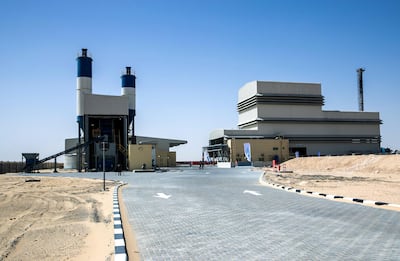Two Dh80 million incinerators built in the heart of the Al Shanayan desert in Abu Dhabi will start processing the emirate's Covid-19 waste next month.
The facilities can burn up to 15,000 tonnes of rubbish every year, and authorities say it will start operating at a crucial time - just as medical and hazardous waste is at its peak during the Covid-19 pandemic.
The Abu Dhabi Waste Management Centre (Tadweer), who runs the plants, also recently spent Dh25 million to expand an existing medical incinerator in Al Ain.
That unit can now treat 1,000 kilograms of waste an hour across its three lines – up from 500kg an hour on two lines.
Face masks, hospital gowns, dressings and discarded surgical and medical equipment, and expired drugs are among the common types of waste that will be processed.
The building of these two new facilities started in 2019, said Mohamed Al Marar, the project manager for Tadweer.
“It takes around two years to build such a plant, because it is for sensitive treatment and requires a lot of approvals for the design.
“As this new facility will be treating waste to the highest standards, we are confident and capable of treating all kinds of medical waste that are generated by the current pandemic,” he said.
The incinerators have also been designed with extra capacity to handle the emirate's waste production over the next decade.
“When we designed the plant, we designed it based on the growth of the population and how this growth would reflect on the waste generated by hospitals and clinics.
“We estimated a 10-year-increase, so the 15,000 tonne capacity can cover the growth of [the next] 10 years,” said Mr Al Marar.
Modernising waste disposal in Abu Dhabi

Previously, medical waste was handled by the hospitals themselves.
But once the plants start operating, all medical and hazardous waste of the emirate will be gradually directed towards the new plants, starting with public hospitals.
The overhaul will ensure all waste “will be treated in accordance with the highest standards”, said Mr Al Marar.
Each plant occupies 4,000 square metres of space, and they are fully automated with minimum human intervention.
At the control room, a screen shows in detail how the machinery is operating.
Five engineers are needed at the control room at a time, to monitor the equipment and control emissions.
“The plant operates 24 hours a day,” said the project manager, “so there will be around three shifts.”
On the ground, around 30 workers load the waste and handle the maintenance of the plant.
“This is considered a low number of workers with the magnitude [of the incinerator],” he added.
How hazardous waste is turned into clean gas
Mr Al Marar explained how waste will be treated at the facility from the instant it arrives at the gate, until it evaporates as clean gas into the atmosphere.
“Every truck that arrives at the door, we have to know the size of the waste it carries,” he said.
The waste is first weighed at a blue belt in front of the entrance, and the system is automatically notified of the results before the rubbish is placed in the container.
If the waste falls under the hazardous category, it is taken to a sterilising and solidification section first.
It is then placed in the incinerator’s first compartment, where the materials are burned at 900°C.
The remaining gases are transferred to a secondary combustion chamber where they are burned at 1,200°C - to ensure any remaining viruses are burnt out.
Then the gas moves to the cooling compartment where is is chilled from 1,200°C to 200°C.
After cooling the air, a process called the cyclone, sucks out all the smoke and dust collected from the chambers.
The air is further purified in the scrubbing chambers, to scrub the acidity off the gases.
Then the air is trapped in a de-mister to remove any remaining moisture, before it passes through a fan and up through a tall stack.
All these measures ensure the waste gas does not pollute the environment, explained Mr Al Marar.
“From the stack it will go to the air outside, but it will be clean gas because we are following a continuous emission monitoring system (CEMS) digitally,” he said.
Throughout the post-burning stages, there are containers under the chambers to collect the ash.
Normally ash is deposited at the landfills, however, Tadweer is considering recycling it as road base material.
This "depends on the quantities we produce, as huge quantities are needed,” said Mr Al Marar.























